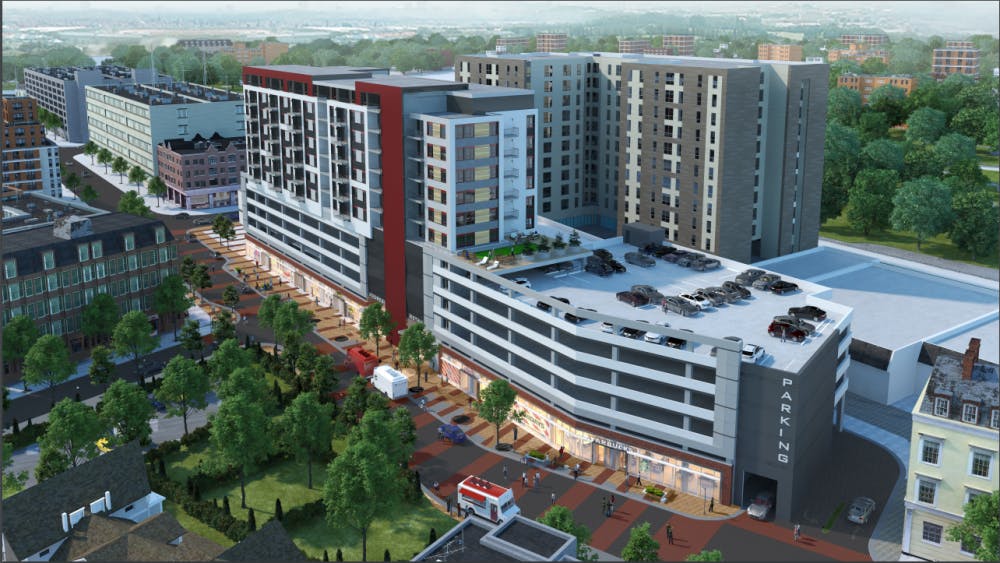The city of East Lansing is now considering two major downtown developments, and whether or not they come to fruition will likely hinge on the financial terms requested by developers, city officials said.
The newly-introduced $132 million Center City District project and the long-awaited Park District project, valued at $148 million in its last incarnation but recently scaled back significantly, will both be financed in part by tax increment financing, or TIF, plans.
TIF plans are used to require developers front the cost for public improvements made during a development that the city would normally be on the hook for. The developer is then reimbursed for the improvements by capturing property tax earnings on the site at a certain rate during a certain amount of time.
East Lansing Mayor Mark Meadows said council approved a brownfield plan — essentially a request for a TIF — for Park District that was about $15 million less than what developer Convexity Properties initially requested.
Convexity called the final plan unworkable and is now in the process of redesigning the project. Meadows estimates Center City developer Harbor Bay Real Estate Advisors will ask for a TIF in the realm of $40-50 million.
Meadows said the city is not liable for any funding on the commercial developments, and any public infrastructure spending will be fronted by the developer and paid back through TIFs.
“We give them back the money they pay us in the amount of the value of those infrastructure improvements,” Meadows said. “Ultimately it doesn’t cost the city anything, frankly.”
Meadows said it is hard to say whether council will approve a new TIF plan for Center City District with Park District still up in the air and details for both projects still coming in. However, Mayor Pro Tem Ruth Beier said the city can definitely afford both developments.
“It’s not the city spending money, it’s the developers (who are) spending money and the developers taking on risk," Beier said. “They’re not really competing against each other, I know everybody thinks they are, but if the developer’s picking up the debt in both cases then we’re not talking about using up the city’s debt limit."
Beier said the terms of the TIF are what matters, not how much money it is worth overall. Beier said she would be willing to provide incentives if the city got something it wanted out of the project, such as the grocery store or senior housing planned for Center City District.
“I want to say the size doesn’t matter at all,” Beier said. “The two things that I will be looking for are one: that the city doesn’t have the debt, and two: that there is some actual revenue coming to the city, and it’s the amount that I think we’ll be bargaining over. Three, that we actually get something. If we’re not going to get anything we want, if we’re just going to get more of what we have, then I would rather not do any development at all.”
Councilmember Erik Altmann said a good case to award a TIF to Center City District could be made if it would pay for public infrastructure and leave enough money in tax revenue to cover both the operating costs of the project and the costs of services for the new city residents that would be living in the project.
“The size of the number itself matters a lot less than those parameters," Altmann said. “A lot depends on the taxable value of the project, if the project would generate a high amount of tax revenue, then that makes it possible to do a large TIF, but … there’s a lot of parameters that we don’t know yet."
In light of East Lansing’s financial problems, Beier said obtaining new sources of revenue is paramount. Meadows said he would prefer a TIF, which would allow the city to begin earning a portion of the property's taxes immediately rather than paying them entirely to the developer. This would be similar to the one approved most recently for Park District, which set an 80 percent abatement on property tax revenues through 30 years, amended from 100 percent through 23.
“That would be the objective of every time we would look at a TIF no matter where it’s it, is to have a positive cash flow to the City of East Lansing, of a volume that actually makes it worthwhile for us to participate with the project,” Meadows said.
Support student media!
Please consider donating to The State News and help fund the future of journalism.
Discussion
Share and discuss “Council: Financing terms key to approval of newly proposed downtown projects” on social media.







